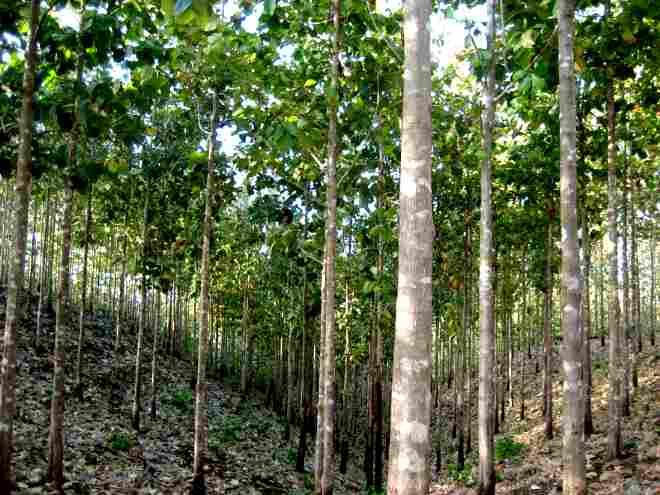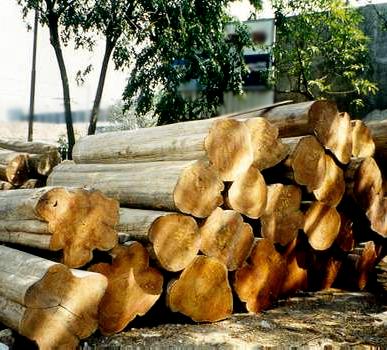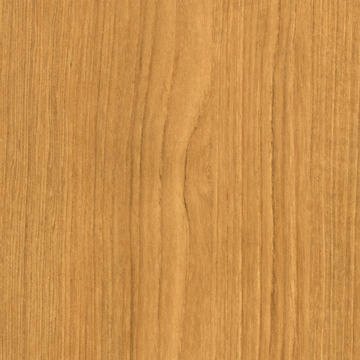
Teak Tectona Hardwood
Species Identity: Teak Tectona Grandis
Family: Verbenaceae
Synonym(s): Jatus grandis (L. f.) Kuntze, Tectonia theca Lour., Theka grandis (L. f.) Lam.
Common Names:
Teak, saigun, Segun (Bengali); kyun (Burmese); Indian oak, teak tree, teak wood (English); dalanang, djati (Filipino); teck (French); Teak(holz)baum, tiek (German); saga, sagach (Gujarati); sagun, sagwan, saigun (Hindi); deleg, jati, kulidawa (Indonesian); teck (Italian); deleg, kulidawa (Javanese); sak (Lao (Sino-Tibetan)); jati (Malay); saguan, teak (Nepali); bardaru, bhumisah, dwardaru, kharchchad, saka (Sanskrit); takku, teaku (Sinhala); teca (Spanish); msaji, mtiki (Swahili); tek, tekku, tekkumaram (Tamil); mai-sak, sak (Thai); teak (Trade name); c[aa]y t[ees]ch, gi[as]
Botanic Description:
Teak Tectona grandis is a large, deciduous tree reaching over 30 m in height in favourable conditions. Crown open with many small branches; the bole is often buttressed and may be fluted, up to 15 m long below the 1st branches, up to 1 m dbh. Bark is brown, distinctly fibrous with shallow, longitudinal fissures. The root system is superficial, often no deeper than 50 cm, but roots may extend laterally up to 15 m from the stem.
The very large, 4-sided leaves are shed for 3-4 months during the later half of the dry season, leaving the branchlets bare. Shiny above, hairy below, vein network clear, about 30 x 20 cm but young leaves up to 1 m long.
Flowers small, about 8 mm across, mauve to white and arranged in large, flowering heads, about 45 cm long; found on the topmost branches in the unshaded part of the crown.
Fruit is a drupe with 4 chambers; round, hard and woody, enclosed in an inflated, bladder-like covering; pale green at first, then brown at maturity. Each fruit may contain 0 to 4 seeds. There are 1 000-3500 fruits/kg.
The generic name comes from ‘tekka’, the Malabar name for T. grandis. The specific name, ‘grandis’, is Latin for ‘large’ or ‘great’.
Teak Tectona Plantation

Ecology and Distribution - History of Cultivation: Its natural distribution is in southeast Asia, from the Indian subcontinent through Myanmar and Thailand to Laos. Whether the ‘natural’ stands in Indonesia are indigenous or the result of early cultivation by Hindu settlers, possibly in the 7th century, is not clearly established. It is believed Teak Tectona was introduced to Java 400-600 years from India.
At the beginning of this century, T. grandis was introduced to both East and West Africa and to the Caribbean region, where ‘Trinidad Teak’ has become particularly well known. For instance, it was introduced into Cote d'Ivoire in 1929. It is planted for timber or ornament and in botanical gardens. Plantations in southeast Asia have been established both within and outside the tree’s natural range. T. grandis was by far the most important export timber in Thailand until all logging in natural forests was banned in 1989. Natural stands in Thailand cover about 2.5 million h.a., plantations 170,000 h.a.. In other southeast Asian countries, it is planted on a comparatively small scale and production is small. As an exotic, it is planted in Bangladesh, Borneo, Cambodia, Malaysia, Pakistan, Philippines, Sri Lanka and Vietnam.
Natural Habitat: T. grandis will survive and grow under a wide range of climatic and edaphic conditions. For example, in northern Togo it grows in a region with an annual rainfall of nearly 600 mm and in Bangladesh a region with close to 4 000 mm. It grows best in a warm, moist, tropical climate with a significant difference between dry and wet seasons. It is a pioneer species, but with a long life span. In contrast to other pioneer species, T. grandis is able to persist and dominate and to naturally regenerate towards the climax phase of succession in most parts of its natural range.
It occurs naturally in various types of tropical deciduous forests. In seasonal climates, T. grandis is deciduous, while trees grown in non-seasonal climates are semi-deciduous. It is often a dominant member of a mixed deciduous forest, where its main associates are Xylia spp., Afzelia xylocarpa, Terminalia spp. and Lagerstroemia spp. The forest floor is often covered with bamboo. T. grandis generally occurs scattered but can form almost pure stands under favourable conditions. Young plants show a remarkable capability to recover after fire.
Teak Tectona Timber

Geographic Distribution: Native: India, Indonesia, Laos, Myanmar, Thailand
Exotic: Antigua and Barbuda, Bangladesh, Barbados, Brazil, Brunei, Cambodia, China, Cote d'Ivoire, Cuba, Dominica, Dominican Republic, Ghana, Grenada, Guadeloupe, Jamaica, Kenya, Malaysia, Mauritius, Nepal, Nigeria, Pakistan, Panama, Philippines, Puerto Rico, South Africa, Sri Lanka, St Lucia, St Vincent and the Grenadines, Tanzania, Togo, Trinidad and Tobago, Uganda, United States of America, Vietnam, Virgin Islands (US)
Biophysical Limits: Altitude: 0-1 200 m, Mean annual temperature: 14-36 deg. C, Mean annual rainfall: (600)1 200-2 500(4 000) mm
Soil Type: Their most suitable soil is deep, well-drained, fertile alluvial-colluvial soil with a pH of 6.5-8 and a relatively high calcium and phosphorous content. The quality of growth, however, depends on the depth, drainage, moisture status and the fertility of the soil. Teak does not tolerate waterlogging or infertile lateritic soils.
Teak Tectona Hardwood

Reproductive Biology: T. grandis is 96-100% self-incompatible. The species is hermaphroditic and pollinated by insects such as black ants, horse flies, and particularly by bees. Fruits mature about 4 months after fertilization. Premature shedding of fruit is a problem. Up to 60% fruit set has been reported following cross-pollination of teak. The individual flower has a 1-day cycle; optimum pollination period is between 1130 h and 1300 h.
Flowering: The height of the tree at the moment of first flowering is important in silviculture. When it is long (it may reach up to 10 m), the final bole form is positively affected, but early-flowering trees may develop extremely wide crowns and short boles. This characteristic is clearly undesirable in timber-crop species and warrants strong selection against flowering in conjunction with increased effort to develop commercial methods of vegetative propagation. The time of the 1st inflorescence is determined by both genetic and environmental factors.
In Thailand, flowering normally starts at the age of 8 to 10 years. However, trees have been observed to flower at the age of 3 months, while a few specimens of superior phenotype did not flower until the age of 27 years. Flowers usually appear during the rainy season, and trees tend to flower synchronously. In Thailand, flowering occurs in June-September and fruiting in November-January. In Java, trees flower every year at the beginning of the rainy season (October-November) and only a few flowers (about 1%) develop into fruits. Fruits fall gradually during the dry season.
Fruit: Although natural fruit set in Thailand is low (0.5-5%), 6 to 60% of fruit set can be achieved by artificial pollination. Fruits develop to full size about 50 days after pollination. They are dispersed by wind over 10-15 m and also by running water after heavy rainfall.
Propagation and Management - Propagation Methods: Natural regeneration is particularly abundant in forests exposed to fires and often occurs in patches. Harvest can take place after natural abscission. In such a case, the stage of ripeness is obvious, but the seed collector is faced with the task of reaching the seed before predators remove it and also of minimizing the effort expended on harvesting poor quality or inviable seed. The best quality fruits are usually the last ones shed.
Seeds collected from the forest floor are generally used to establish plantations. It is recommended that seeds be collected from trees over 20 years old. Seed is often collected from selected stands. The general practice is to use fruits stored for a year after soaking them in water for 24 hours. Fruit that has lain dormant in the ground for 30 to 40 years has been known to germinate abundantly. If it is necessary to use fruits from the same year, they should be subjected to alternate wetting then drying for 24 hours each for 14 days. Soaking the fruit for 48 hours in running water before sowing is the best treatment for hastening germination. Another method is to char (or half burn) the fruits by covering them with a thin layer of grass and lighting it. The germination rate is low, usually less than 50%, but sometimes up to 80%. Germination usually starts after 10 days but may take 2 to 3 months.
Seedlings exhibit epigeal germination. Although Teak demands strong light, it prefers slight shading during the seedling stage. In Thailand, seedlings are kept in nursery beds for about a year. Then the rootstock is dug up, the stem cut off, and the stump planted into the field. Direct sowing into the field at the beginning of the rainy season is often practised in Java.
Both grafting and budding methods showed better results than branch cutting methods. The rooting time of cutting is 8 to 15 days, and the survival rate of rooted stock is 90-100%.
Shoots can grow to 3 m in 2 years. Tissue cultures have been perfected for T. grandis. It is possible to produce 500 plants from a single bud of a mature tree or 3000 plants from a seedling in a year. Tissue-cultured plants possess better growth than seed-grown plants.
Tree Management: For plantations, stumps are planted at a spacing of 2 x 2 m. As the tree is deciduous, raising pure plantations is discouraged; rather, it is recommended to raise 80% of mixed indigenous species and the remaining 20% T. grandis. Fire protection is important; each year’s planting area should be should be protected by a fire line 10 m wide, which is cleared of all vegetation. Plantations must also be protected from grazing animals, as the soil is often susceptible to erosion. Coppicing and weeding should also be practised. T. grandis is a very strong light demander, and the optimum for its growth lies at 75-100% of full sunlight. It is intolerant of crown friction.
Initial growth of the tree is rapid. At an age of 5 years, an average height of 13 m and 10 cm dbh is not unusual; after 10 years, 16.5 m and 15 cm; after 20 years, 21.5 m and 23.5 cm. After 15 or 20 years, growth slows down. In stands of 80-year-old trees, maximum height is about 45 m, with a maximum diameter of 75 cm. Thinning takes place 4 times, at 5-, 10-, 18- and 28-year intervals after planting. The rotation period is approximately 80 years.
The average plantation yield in Java is 60-100 m³/ha, including thinning. Occasionally the final harvest may yield as much as 390 m³/ha in stands 80 years old. The mean annual volume increment is (min. 1) 3-6 (max. 15) m³/ha.
Germplasm Management: To reduce bulk in storage, the seed can be husked by rubbing it over a sieve. Another method is to load seed and large river gravel into a cement mixer. The seed can then be ‘floated’ off. Stumps, used for propagation, can be stored for up to a year.
Seed storage behaviour is orthodox. Viability can be maintained for at least 7 years in hermetic, air-dry storage at room temperature; there is no loss in viability after 7 years in hermetic, air-dry storage at 0-4 deg. C with 12% mc. Seed can be maintained for 10 years in hermetic, air-dry storage at 2 deg. C. There are 800-2 000 seeds/kg.
Functional Uses - Products:
- Fuel: Tectona has been used in the manufacture of charcoal and as fuelwood, but nowadays it is usually considered too valuable for anything but pruning remnants and other rejects to be used in this way.
- Timber: A rare combination of superior physical and mechanical properties makes T. grandis a paragon of timber, and there is no likelihood of it being eclipsed by any other. The wood is a medium weight timber that is rather soft and has a characteristic appearance. The heartwood is often dull yellowish when freshly cut but turns golden brown or sometimes dark greyish-brown after exposure, often streaked grey or black. The sapwood is yellowish-white or pale yellowish-brown and up to 50 mm thick. Grain is straight, wavy or slightly interlocked, with rather coarse and uneven texture. Density of the wood is (min. 480) 610-750 (max. 850) kg/m³ at 12% mc. The wood is oily to the touch and when freshly cut has a smell reminiscent of leather.
Being classified as very resistant to teredo activity, the wood is excellent timber for bridge building and other construction in contact with water such as docks, quays, piers and floodgates in fresh water. In house building, teakwood is particularly suitable for interior and exterior joinery (windows, solid panel doors and framing) and is used for floors exposed to light to moderate pedestrian traffic. It is also used quite extensively for garden furniture. Other uses are for building poles, transmission line poles, fence posts, wallboards, beams, woodwork, boxes, musical instruments, toys, railway sleepers and railcar construction. It is brittle and therefore less suitable for articles requiring high resilience, such as tool handles and sporting goods. Its high resistance to a wide variety of chemicals makes it ideal for laboratory and kitchen tables as well as for scrubbing towers, vats, pipes and fume ducts in industrial chemical plants. The wood grains are figured well, producing an attractive veneer, which is extensively used in the manufacture of furniture and interior fittings. Tectona is suitable for the manufacture of decorative plywood.
Larger logs are utilized for beams and sleepers, smaller ones for scantlings and battens, and thinner top ends and poles are used as round posts. Thinnings are also used for timber. The wood is very durable, difficult to preserve, saws fairly and seasons easily. For the export market, teakwood is recommended for ship decking and other constructional work in boat building. T. grandis is economically one of the most important timber tree species of Indonesia.
- Tannin or Dyestuff: Both the rootbark and the young leaves produce a yellowish-brown or reddish dye, which is used for paper, clothes and matting.
- Medicine: In traditional medicine, a wood powder paste has been used against bilious headaches and swellings and internally against dermatitis or as a vermifuge. The charred wood soaked in poppy juice and made into a paste has been used to relieve the swelling of the eyelids. The bark has been used as an astringent and the wood as a hair tonic.
- Other products: Sawdust from teakwood is used as incense in Java; the dust, however, may irritate the skin.
Services:
- Ornamental: T. grandis is occasionally cultivated in tropical countries as an ornamental for its large leaves and spreading flower clusters. The species was originally introduced into Malaysia as a roadside and ornamental tree.
- Intercropping: Soya bean mixed with T. grandis not only makes the latter grow better but also allows harvesting of the bean for food; the soya stems, roots and leaves are added to the soil as fertilizer.
Pests and Diseases: The main attack on the stems is by the insect Calothermes tectonae. At first sign of attack, trees should be felled and burned, because no effective insecticide is known. Other plantation pests are Eutectona machaeralis (teak skeletonizer) and woodborers Xyleutes ceramicus in Thailand and Xyleborus destruens in Indonesia. Leaf-eating caterpillars such as Hyblaea puera and Pyrausta machaeralis may defoliate branches. Termites such as Neotermes tectonae may damage the trees, although many provenances show a high resistance. Seeds can be infested by larvae of Lepidoptera and Coleoptera (longhorn beetles).
A bacterial wilt caused by Pseudomonas solanacearum often attacks 6-month to 2-year-old seedlings. To control, choose a nursery site with good drainage and avoid root injury during weeding and transplanting. Fungi such as Corticium salmonicolor can cause disease. Crowns are often infested by semi-parasitic mistletoes, such as Loranthus spp. and Dendrophthoe falcata, which cause severe retardation; lopping affected branches controls them.
references:
(1) Albrecht J. ed. 1993. Tree seed hand book of Kenya. GTZ Forestry Seed Center Muguga, Nairobi, Kenya.
(2) Anon. 1986. The useful plants of India. Publications & Information Directorate, CSIR, New Delhi, India.
(3) Burley J, Styles BT. 1976. Tropical trees: variation, breeding and conservation. Linnean Society Symposium Series No. 2. Academic Press.
(4) Day RK, Rudgard SA, Nair KSS (eds.). 1994. Asian tree pests: an overview. CAB International, UK.
(5) Hong TD, Linington S, Ellis RH. 1996. Seed storage behaviour: a compendium. Handbooks for Genebanks: No. 4. IPGRI.
(6) Kaosa-ard A. 1986. Teak (Tectona grandis Linn. f.). ASEAN, a survey report. ASEAN/Canada Forest Seed Centre.
(7) Katende AB et al. 1995. Useful trees and shrubs for Uganda. Identification, Propagation and Management for Agricultural and Pastoral Communities. Regional Soil Conservation Unit (RSCU), Swedish International Development Authority (SIDA).
(8) Kayastha BP. 1985. Silvics of the trees of Nepal. Community Forest Development Project, Kathmandu.
(9) Kerala Agricultural University. 2002. Package of Practices Recommendations: Crops. 12th Edition (eds. A. I. Jose et al.). Kerala Agricultural University, Trichur. 278p.
(10) Kokwaro JO. 1976. Medicinal plants of East Africa. East African Literature Bureau.
(11) Lanzara P. and Pizzetti M. 1978. Simon & Schuster's Guide to Trees. New York: Simon and Schuster
(12) Little EL, Wadsworth FH. 1964. Common trees of Puerto Rico and the Virgin Islands.
(13) Agricultural Handbook. No. 249. US Department of Agriculture. Washington DC.
(14) Mbuya LP et al. 1994. Useful trees and shrubs for Tanzania: Identification, Propagation and Management for Agricultural and Pastoral Communities. Regional Soil Conservation Unit (RSCU), Swedish International Development Authority (SIDA).
(15) Perry LM. 1980. Medicinal plants of East and South East Asia : attributed properties and uses. MIT Press. South East Asia.
(16) Sedgley M, Griffin AR. 1989. Sexual reproduction of tree crops. Academic Press. London.
(17) Soerianegara I, Lemmens RHMJ (eds.). 1993. Plant Resources of South-East Asia. No. 5, Timber trees: major commercial timbers. Backhuys Publishers, Leiden.
(18) Streets RJ. 1962. Exotic forest trees in the British Commonwealth. Clarendon Press, Oxford.
(19) Wood H. 1992. Teak in Asia. Proceedings of the China/ESCAP/FAO Regional Seminar on Research and Development of Teak. 19-27 March 1991.
(20) ITWA International Teak Woods Association